Statistical Assessment of Open Optical Networks
Abstract
1. Introduction
2. Network Abstraction in Open Optical Networks
2.1. From the Physical Layer to the Graph Representation
2.2. Routing Strategies
- For each traffic request, the shortest paths are explored;
- For each of the selected paths, all the waveplanes are scanned until a suitable working LP to accommodate the request. LP selection is done by considering the weights of the edges of the available optical paths;
- Whenever a demand is allocated, the edges of that waveplane corresponding to the LP are labelled as busy;
- If a request cannot be allocated, it is counted as rejected and the RWA moves to the next request.
3. SNAP: Statistical Network Assessment Process
- Description of the Network Topology and Physical Layer: a set of network nodes and their relative connectivity matrix describe the network topology. Beyond this logical description, the set of physical parameters describing the hardware composing the network must be provided. For example, a network node could be physically characterized simply as the ROADM loss and the noise figure (NF) of the amplifier recovering its loss or even by a more complex model characterizing its filtering effect. As for the optical fiber links connecting the nodes, we take into account the fiber type (with its physical parameters such as length, attenuation coefficient, dispersion and effective area) and the inline amplifiers NF. This data is then used to estimate the QoT metric of each LP, such as the SNR degradation, via the model of choice [16]. However, note that it is also possible to provide directly the graph and the weights of its edges.
- Spectral Information and Network Management Strategies: This set of parameters describes how the network hardware should be operated. This includes:
- Spectral Information: the description of the transceivers generating and receiving the data signals to inject into the network. This involves the used spectral region (C-Band, L-Band, Multiband, etc.), fixed or flexible-grid spectral allocation, grid size, fixed or multi-rate transmission, symbol rate, FEC overhead and pre-FEC target BER;
- Power Control Plan: this defines the power management strategy used for transmission along the optical paths, such as the LOGO strategy for SNR optimization;
- Routing and Spectrum/Wavelength Assignment (RSWA) algorithm: This describes how the optical paths between a nodes pairs are evaluated and ranked and spectral slots assigned to LPs, i.e., the routing policy. For example, a shortest link or lowest latency routing could be adopted as well as best-QoT routing.
- Traffic Model Description: The traffic loading the network is given as a set of LP allocation requests between two network nodes. In addition, pre-existing legacy traffic loading the network is supported. A certain number of Monte Carlo realizations to run over must be set due to the stochastic nature of the traffic requests in order to provide reliable network statistics. This tuning will be shown once in Section 5.1 by looking at the convergence of the average bit-rate per LP, so that results are indeed probability density functions (PDFs) of targeted metrics. As described in the following, SNAP supports two models for traffic loading, identified as given traffic or progressive traffic analyses.
- Given Traffic Analysis: as described in the left-side pseudocode of Table 1, we define a traffic matrix D, whose elements may represent either a connection request or a data-rate request between nodes l and m. In the former case, represents the number of LPs to be established between nodes l and m. In the latter, it is a transport request between nodes l and m of groomed traffic of size that the physical layer should be fulfilled according to the transceiver technology (fixed- or multi-rate) and spectral allocation strategy (fix- or flex-grid). For example, a D matrix such that ∀ and for represents an any-to-any connectivity case, i.e., each node can request a LP to each of the other nodes except to itself. At each Monte Carlo iteration, the randomness of the LP requests lies in the order in which the elements are picked up. For each the algorithm tries to allocate a LP, i.e., a suitable wavelength and optical path according to the RSWA strategy. If the LP allocation is successful, the corresponding bit-rate is collected, n being the index of the n-th allocated LP at the i-th Monte Carlo iteration. Otherwise, the missed allocation counter is incremented. After all the ’s are processed by the RSWA algorithm, the network loading loop terminates, so that the network reaching the saturation state is not assured. Hence, this analysis is aimed at deriving static metrics by looking at the network status after each loading loop. The loading loop is repeated for each Monte Carlo iteration and static metrics are finally calculated from the obtained PDFs.
- Progressive Traffic Analysis: with respect to the right-side pseudocode of Table 1, in this case, LP alllocation requests are issued indefinitely with the progressive loading loop on i-th Monte-Carlo iteration. Traffic requests are generated according to a probability mass function in the space of the source/destination nodes, expressing the probability that a connection request between nodes might occur. In SNAP, we assume that this probability distribution is uniform among the nodes at each iteration i, so that the connection request probability is equal to and constant for each nodes pair, being the number of network nodes generating and receiving traffic. As for the given traffic case, LP allocation requests can be either connection requests or data-rate requests. In turn, the grooming size can be fixed and defined at the logical level or generated from a certain probability distribution. Similarly to the given traffic case, if an LP can be allocated for the issued request, the corresponding bit-rate is calculated; otherwise, the missed allocation counter is incremented. Here, however, the network loading loop terminates at network saturation, i.e., when subsequent requests for connections are blocked. Hence, progressive traffic analysis is suitable for both static and dynamic metrics estimation, since statistics at a certain network load level or at network saturation can be obtained. The loading loop is repeated times and, in the end, performance metrics are obtained from the obtained PDFs.
- Average bit-rate per LP of Equation (4);
- Spectral saturation: the spectral occupation of each node-to-node fiber connection;
- Blocking information: the number of blocked demands for each node or link;
- Acceptance information: the number of demands accepted in each node.
- Blocking Probability: the probability of demand being blocked after demand j. can be considered the Quality-of-Service (QoS) figure of merit of the network under progressive loading;
- Total allocated network traffic: obtained as the sum of the number of allocated LP requests up to the j-th demand. Selecting a target QoS, one can evaluate the average maximum traffic supported by the network at that target QoS;
- Link saturation: the number of the allocated LPs in the overall available bandwidth in each network link.
4. Given Traffic Results
5. Progressive Traffic Results
5.1. Preliminary Results on SNAP Algorithm Convergence
5.2. Network NLI Penalty Assessment with Pure/Hybrid Modulation Formats
5.3. QoT-E Layer Analysis
5.4. Network Impact of Fixed and Hybrid Rate Transceivers
5.5. Fixed vs. Flexible Frequency Grid Comparison
5.6. Networking with Different SDM Solutions
- UFR with CCC,
- UFR with InS,
- SCMCF with JoS and NLM,
- SCMCF with JoS and without NLM.
6. Conclusions
Funding
Acknowledgments
Conflicts of Interest
References
- Cisco. Cisco Visual Networking Index: Forecast and Trends, 2017–2022; Technical Report; Cisco: San Jose, CA, USA, 2017. [Google Scholar]
- Wellbrock, G.; Xia, T.J. How will optical transport deal with future network traffic growth? In Proceedings of the 2014 The European Conference on Optical Communication (ECOC), Cannes, France, 21–25 September 2014. [Google Scholar] [CrossRef]
- Essiambre, R.J.; Tkach, R.W. Capacity Trends and Limits of Optical Communication Networks. Proc. IEEE 2012, 100, 1035–1055. [Google Scholar] [CrossRef]
- Zhou, X.; Nelson, L.E.; Magill, P. Rate-adaptable optics for next generation long-haul transport networks. IEEE Commun. Mag. 2013, 51, 41–49. [Google Scholar] [CrossRef]
- Dai, H.; Li, Y.; Shen, G. Explore Maximal Potential Capacity of WDM Optical Networks Using Time Domain Hybrid Modulation Technique. J. Lightw. Technol. 2015, 33, 3815–3826. [Google Scholar] [CrossRef]
- Shen, G.; Bose, S.; Cheng, T.; Lu, C.; Chai, T. Efficient heuristic algorithms for light-path routing and wavelength assignment in WDM networks under dynamically varying loads. Comput. Commun. 2001, 24, 364–373. [Google Scholar] [CrossRef]
- Cantono, M.; Gaudino, R.; Curri, V. Potentialities and Criticalities of Flexible-Rate Transponders in DWDM Networks: A Statistical Approach. J. Opt. Commun. Netw. 2016, 8, A76. [Google Scholar] [CrossRef]
- Carena, A.; Curri, V.; Bosco, G.; Poggiolini, P.; Forghieri, F. Modeling of the Impact of Nonlinear Propagation Effects in Uncompensated Optical Coherent Transmission Links. J. Lightw. Technol. 2012, 30, 1524–1539. [Google Scholar] [CrossRef]
- Bononi, A.; Serena, P.; Rossi, N.; Grellier, E.; Vacondio, F. Modeling nonlinearity in coherent transmissions with dominant intrachannel-four-wave-mixing. Opt. Express 2012, 20, 7777. [Google Scholar] [CrossRef] [PubMed]
- Mecozzi, A.; Essiambre, R.J. Nonlinear Shannon Limit in Pseudolinear Coherent Systems. J. Lightw. Technol. 2012, 30, 2011–2024. [Google Scholar] [CrossRef]
- Secondini, M.; Forestieri, E. Analytical Fiber-Optic Channel Model in the Presence of Cross-Phase Modulation. IEEE Photon. Technol. Lett. 2012, 24, 2016–2019. [Google Scholar] [CrossRef]
- Johannisson, P.; Karlsson, M. Perturbation Analysis of Nonlinear Propagation in a Strongly Dispersive Optical Communication System. J. Lightw. Technol. 2013, 31, 1273–1282. [Google Scholar] [CrossRef]
- Dar, R.; Feder, M.; Mecozzi, A.; Shtaif, M. Properties of nonlinear noise in long, dispersion-uncompensated fiber links. Opt. Express 2013, 21, 25685. [Google Scholar] [CrossRef] [PubMed]
- Serena, P.; Bononi, A. An Alternative Approach to the Gaussian Noise Model and its System Implications. J. Lightw. Technol. 2013, 31, 3489–3499. [Google Scholar] [CrossRef]
- Secondini, M.; Forestieri, E.; Prati, G. Achievable Information Rate in Nonlinear WDM Fiber-Optic Systems With Arbitrary Modulation Formats and Dispersion Maps. J. Lightw. Technol. 2013, 31, 3839–3852. [Google Scholar] [CrossRef]
- Poggiolini, P.; Bosco, G.; Carena, A.; Curri, V.; Jiang, Y.; Forghieri, F. The GN-Model of Fiber Non-Linear Propagation and its Applications. J. Lightw. Technol. 2014, 32, 694–721. [Google Scholar] [CrossRef]
- Dar, R.; Feder, M.; Mecozzi, A.; Shtaif, M. Accumulation of nonlinear interference noise in fiber-optic systems. Opt. Express 2014, 22, 14199. [Google Scholar] [CrossRef] [PubMed]
- Poggiolini, P.; Bosco, G.; Carena, A.; Cigliutti, R.; Curri, V.; Forghieri, F.; Pastorelli, R.; Piciaccia, S. The LOGON Strategy for Low-Complexity Control Plane Implementation in New-Generation Flexible Networks. In Proceedings of the Optical Fiber Communication Conference/National Fiber Optic Engineers Conference 2013, Anaheim, CA, USA, 17–21 March 2013. [Google Scholar] [CrossRef]
- Pastorelli, R.; Bosco, G.; Piciaccia, S.; Forghieri, F. Network Planning Strategies for Next-Generation Flexible Optical Networks. J. Opt. Commun. Netw. 2015, 7, A511. [Google Scholar] [CrossRef]
- Pastorelli, R. Network Optimization Strategies and Control Plane Impacts. In Proceedings of the 2015 Optical Fiber Communications Conference and Exhibition (OFC), Los Angeles, CA, USA, 22–26 March 2015. [Google Scholar] [CrossRef]
- Curri, V.; Carena, A.; Arduino, A.; Bosco, G.; Poggiolini, P.; Nespola, A.; Forghieri, F. Design Strategies and Merit of System Parameters for Uniform Uncompensated Links Supporting Nyquist-WDM Transmission. J. Lightw. Technol. 2015, 33, 3921–3932. [Google Scholar] [CrossRef]
- Kamalov, V.; Cantono, M.; Vusirikala, V.; Jovanovski, L.; Salsi, M.; Pilipetskii, A.; Kovsh Maxim Bolshtyansky, D.; Mohs, G.; Rivera Hartling, E.; Grubb, S.; et al. The subsea fiber as a Shannon channel. In Proceedings of the SubOptic 2019, New Orleans, LA, USA, 8–11 April 2019. [Google Scholar]
- Filer, M.; Cantono, M.; Ferrari, A.; Grammel, G.; Galimberti, G.; Curri, V. Multi-Vendor Experimental Validation of an Open Source QoT Estimator for Optical Networks. J. Lightw. Technol. 2018, 36, 3073–3082. [Google Scholar] [CrossRef]
- Cantono, M.; Gaudino, R.; Curri, V. Data-rate figure of merit for physical layer in fixed-grid reconfigurable optical networks. In Proceedings of the 2016 Optical Fiber Communications Conference and Exhibition (OFC), Anaheim, CA, USA, 20–24 March 2016. [Google Scholar] [CrossRef]
- Dijkstra, E.W. A note on two problems in connexion with graphs. Numer. Math. 1959, 1, 269–271. [Google Scholar] [CrossRef]
- Curri, V.; Cantono, M.; Gaudino, R. Elastic All-Optical Networks: A New Paradigm Enabled by the Physical Layer. How to Optimize Network Performances? J. Lightw. Technol. 2017, 35, 1211–1221. [Google Scholar] [CrossRef]
- Cantono, M.; Gaudino, R.; Curri, V. A statistical analysis of transparent optical networks comparing merit of fiber types and elastic transceivers. In Proceedings of the 2016 18th International Conference on Transparent Optical Networks (ICTON), Trento, Italy, 10–14 July 2016. [Google Scholar] [CrossRef]
- Cantono, M.; Gaudino, R.; Curri, V. The Statistical Network Assessment Process (SNAP) to evaluate benefits of amplifiers and transponders’ upgrades. In Proceedings of the 18th Italian National Conference on Photonic Technologies (Fotonica 2016), Rome, Italy, 6–8 June 2016. [Google Scholar] [CrossRef]
- Cantono, M.; Curri, V. Flex- vs. fix-grid merit in progressive loading of networks already carrying legacy traffic. In Proceedings of the 2017 19th International Conference on Transparent Optical Networks (ICTON), Girona, Spain, 2–6 July 2017. [Google Scholar] [CrossRef]
- Cantono, M.; Piciaccia, S.; Tanzi, A.; Galimberti, G.M.; Smith, B.; Bianchi, M.; Curri, V. A Statistical Assessment of Networking Merit of 2MxN WSS. In Proceedings of the 2018 Optical Fiber Communications Conference and Exposition (OFC), San Diego, CA, USA, 11–15 March 2018. [Google Scholar]
- Ferrari, A.; Cantono, M.; Curri, V. Coupled vs Uncoupled SDM Solutions: A Physical Layer Aware Networking Comparison. In Proceedings of the 2018 20th International Conference on Transparent Optical Networks (ICTON), Bucharest, Romania, 1–5 July 2018. [Google Scholar] [CrossRef]
- Ferrari, A.; Cantono, M.; Curri, V. A Networking Comparison Between Multicore Fiber and Fiber Ribbon in WDM-SDM Optical Networks. In Proceedings of the 2018 European Conference on Optical Communication (ECOC), Rome, Italy, 23–27 September 2018; pp. 1–3. [Google Scholar]
- Yan, L.; Xu, Y.; Brandt-Pearce, M.; Dharmaweera, N.; Agrell, E. Regenerator Site Predeployment in Nonlinear Dynamic Flexible-Grid Networks. In Proceedings of the 2017 European Conference on Optical Communication (ECOC), Gothenburg, Sweden, 17–21 September 2017. [Google Scholar] [CrossRef]
- Cantono, M. Physical Layer Aware Optical Networks. Ph.D. Thesis, Politecnico di Torino, Turin, Italy, 2018. [Google Scholar]
- Curri, V.; Carena, A.; Poggiolini, P.; Cigliutti, R.; Forghieri, F.; Fludger, C.; Kupfer, T. Time-Division Hybrid Modulation Formats: Tx Operation Strategies and Countermeasures to Nonlinear Propagation. In Proceedings of the Optical Fiber Communication Conference, San Francisco, CA, USA, 9–13 March 2014. [Google Scholar] [CrossRef]
- Guiomar, F.P.; Li, R.; Fludger, C.R.S.; Carena, A.; Curri, V. Hybrid Modulation Formats Enabling Elastic Fixed-Grid Optical Networks. J. Opt. Commun. Netw. 2016, 8, A92. [Google Scholar] [CrossRef]
- Poggiolini, P.; Bosco, G.; Carena, A.; Curri, V.; Jiang, Y.; Forghieri, F. A Simple and Effective Closed-Form GN Model Correction Formula Accounting for Signal Non-Gaussian Distribution. J. Lightw. Technol. 2015, 33, 459–473. [Google Scholar] [CrossRef]
- Bohn, M.; Napoli, A.; D’Errico, A.; Ferraris, G.; Gunkel, M.; Jimenez, F.; Fernandez-Palacios, J.P.; Layec, P.; Zervas, G. Elastic optical networks: The vision of the ICT project IDEALIST. In Proceedings of the 2013 Future Network and Mobile Summit, Lisboa, Portugal, 3–5 July 2013. [Google Scholar]
- Ives, D.J.; Bayvel, P.; Savory, S.J. Assessment of Options for Utilizing SNR Margin to Increase Network Data Throughput. In Proceedings of the 2015 Optical Fiber Communications Conference and Exhibition (OFC), Los Angeles, CA, USA, 22–26 March 2015. [Google Scholar] [CrossRef]
- Poggiolini, P. The GN Model of Non-Linear Propagation in Uncompensated Coherent Optical Systems. J. Lightw. Technol. 2012, 30, 3857–3879. [Google Scholar] [CrossRef]
- Ives, D.J.; Wright, P.; Lord, A.; Savory, S.J. Using 25GbE Client Rates to Access the Gains of Adaptive Bit- and Code-Rate Networking. J. Opt. Commun. Netw. 2016, 8, A86. [Google Scholar] [CrossRef]
- Winzer, P.J. Optical Networking Beyond WDM. IEEE Photon. J. 2012, 4, 647–651. [Google Scholar] [CrossRef]
- Matsuo, S.; Takenaga, K.; Saitoh, K.; Nakajima, K.; Miyamoto, Y.; Morioka, T. High-spatial-multiplicity multi-core fibres for future dense space-division-multiplexing system. In Proceedings of the 2015 European Conference on Optical Communication (ECOC), Valencia, Spain, 27 September–1 October 2015. [Google Scholar] [CrossRef]
- Pederzolli, F.; Siracusa, D.; Shariati, B.; Rivas-Moscoso, J.M.; Salvadori, E.; Tomkos, I. Improving Performance of Spatially Joint-Switched Space Division Multiplexing Optical Networks via Spatial Group Sharing. J. Opt. Commun. Netw. 2017, 9, B1. [Google Scholar] [CrossRef]
- Rumipamba-Zambrano, R.; Moreno-Muro, F.J.; Pavon-Marino, P.; Perello, J.; Spadaro, S.; Sole-Pareta, J. Assessment of Flex-Grid/MCF Optical Networks with ROADM limited core switching capability. In Proceedings of the 2017 International Conference on Optical Network Design and Modeling (ONDM), Budapest, Hungary, 15–18 May 2017. [Google Scholar] [CrossRef]
- Ryf, R.; Alvarado, J.C.; Huang, B.; Antonio-Lopez, J.; Chang, S.H.; Fontaine, N.K.; Chen, H.; Essiambre, R.; Burrows, E.; Amezcua-Correa, R.; et al. Long-Distance Transmission over Coupled-Core Multicore Fiber. In Proceedings of the ECOC 2016—Post Deadline Paper; 42nd European Conference on Optical Communication, Dusseldorf, Germany, 18–22 September 2016. [Google Scholar]
- Antonelli, C.; Shtaif, M.; Mecozzi, A. Modeling of Nonlinear Propagation in Space-Division Multiplexed Fiber-Optic Transmission. J. Lightw. Technol. 2016, 34, 36–54. [Google Scholar] [CrossRef]
- Khodashenas, P.S.; Rivas-Moscoso, J.M.; Siracusa, D.; Pederzolli, F.; Shariati, B.; Klonidis, D.; Salvadori, E.; Tomkos, I. Comparison of Spectral and Spatial Super-Channel Allocation Schemes for SDM Networks. J. Lightw. Technol. 2016, 34, 2710–2716. [Google Scholar] [CrossRef]
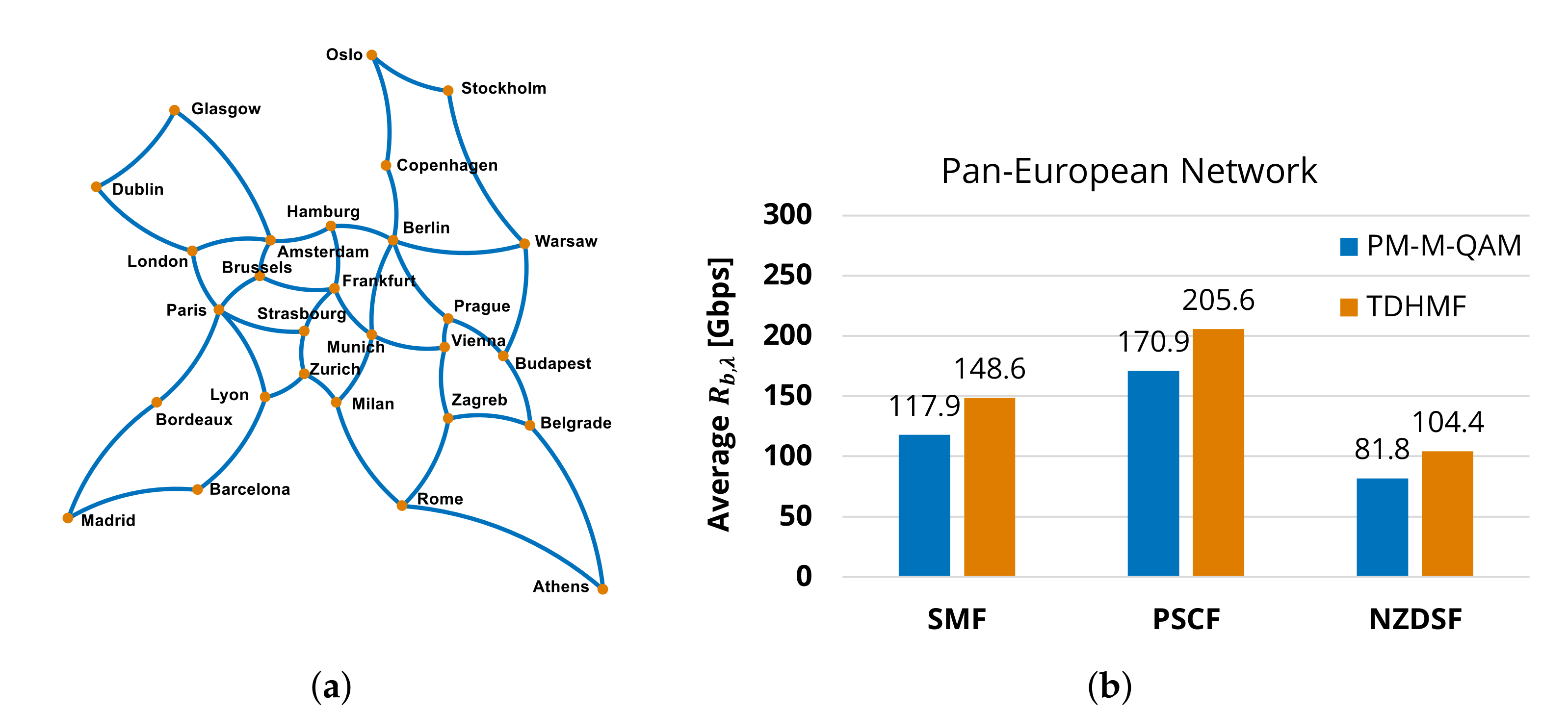
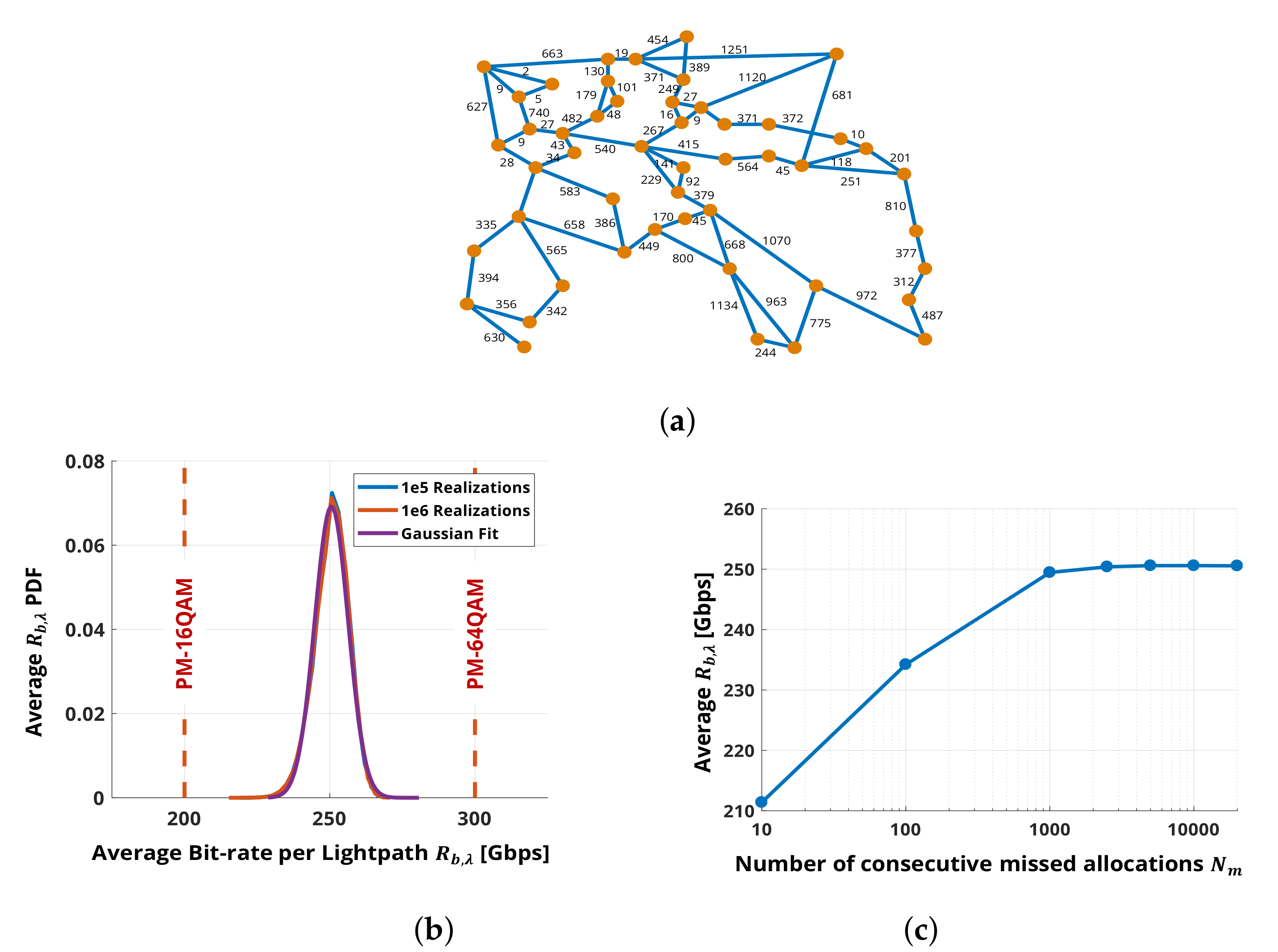
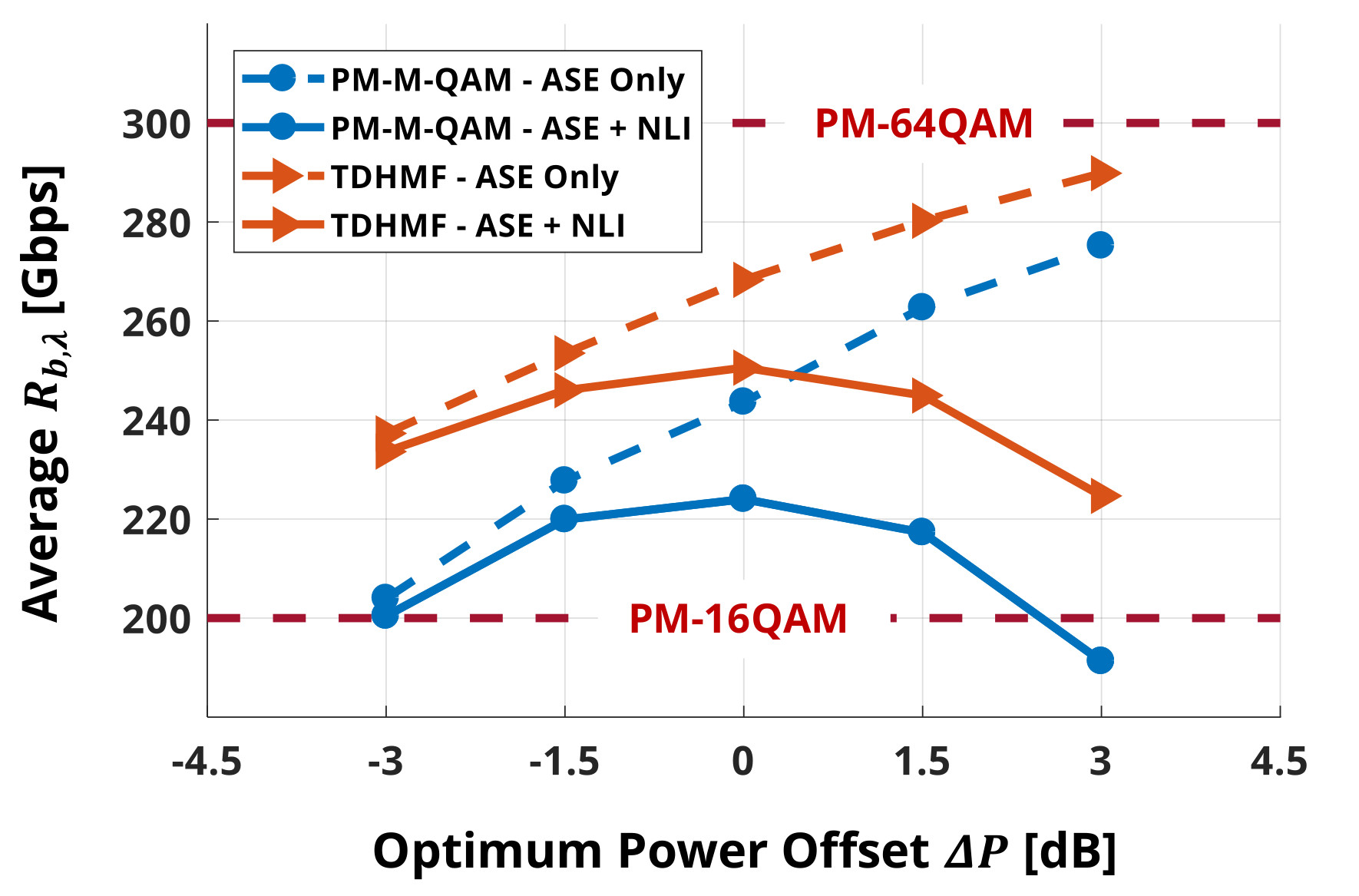
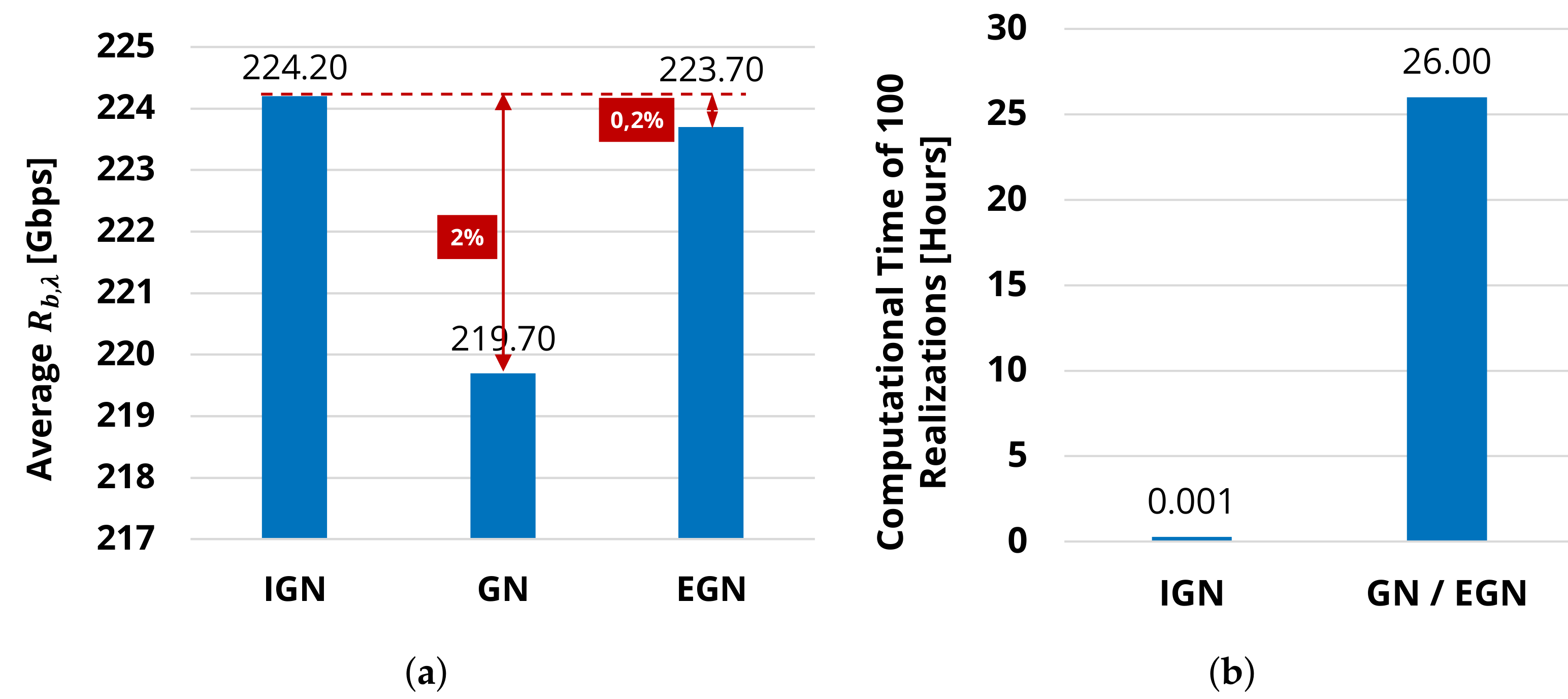
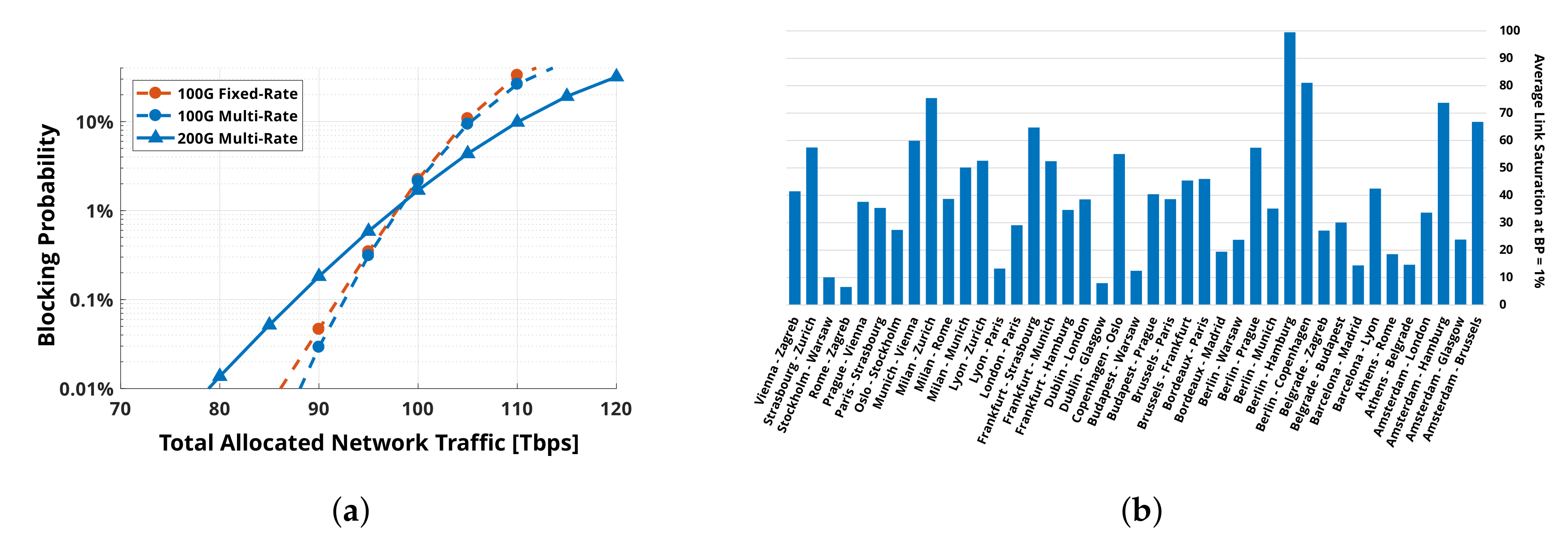
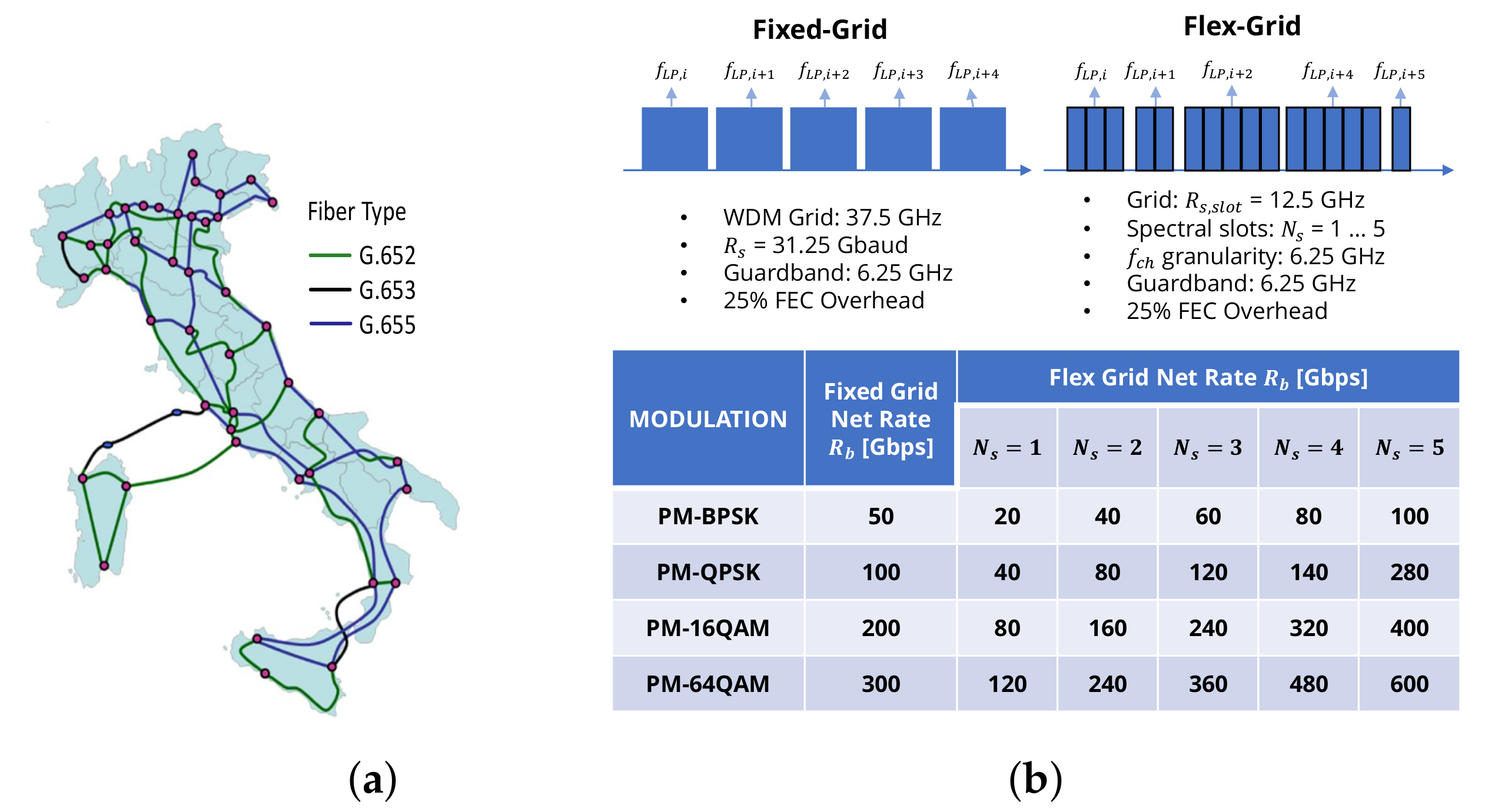

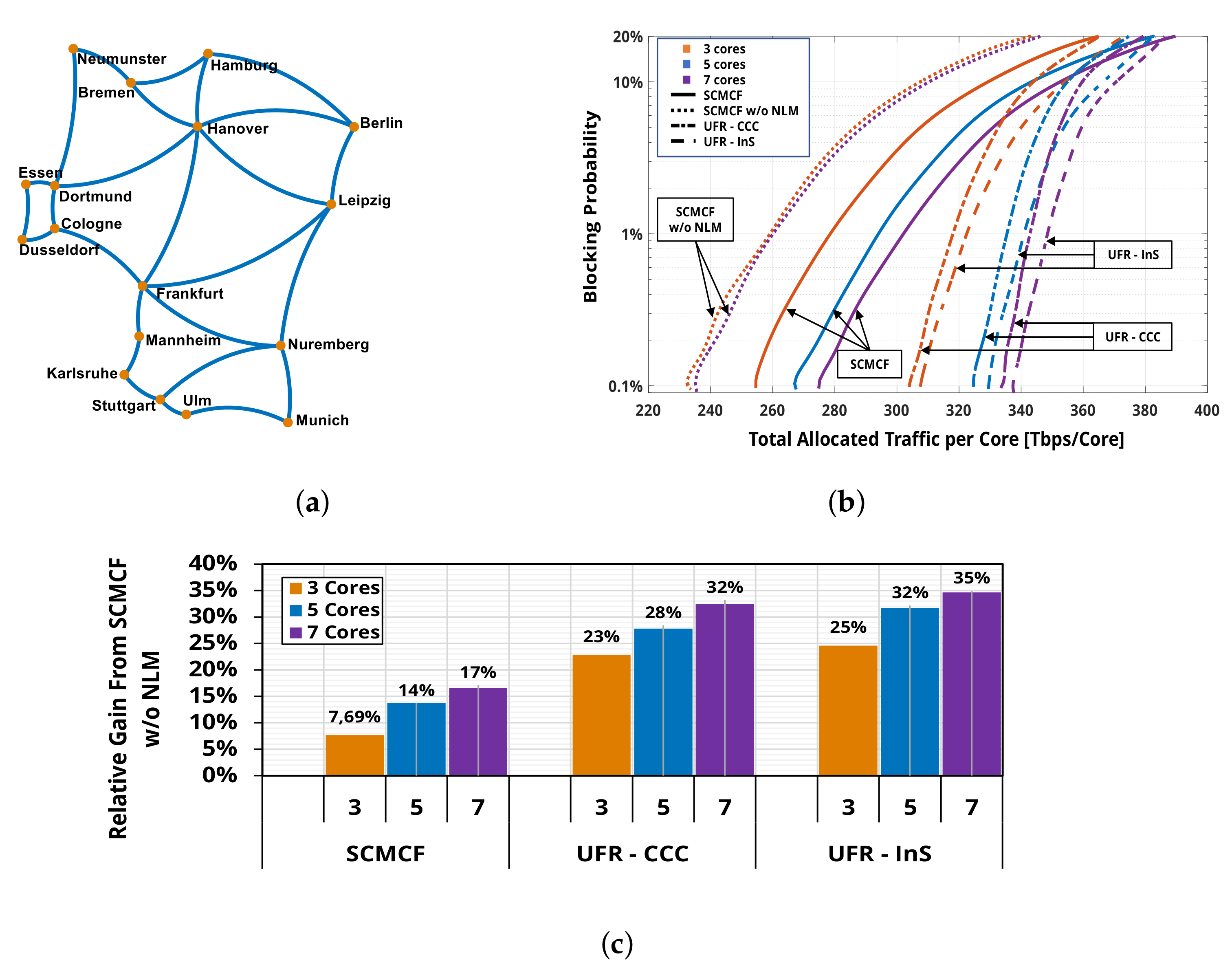

| Fiber Type | Loss [dB/km] | Dispersion D [ps/(nm · km)] | Effective Area [m] |
|---|---|---|---|
| NZDSF | 0.220 | 3.8 | 70 |
| SMF | 0.200 | 16.7 | 80 |
| PSCF | 0.167 | 21.0 | 135 |
© 2019 by the authors. Licensee MDPI, Basel, Switzerland. This article is an open access article distributed under the terms and conditions of the Creative Commons Attribution (CC BY) license (http://creativecommons.org/licenses/by/4.0/).
Share and Cite
Virgillito, E.; Ferrari, A.; D’Amico, A.; Curri, V. Statistical Assessment of Open Optical Networks. Photonics 2019, 6, 64. https://doi.org/10.3390/photonics6020064
Virgillito E, Ferrari A, D’Amico A, Curri V. Statistical Assessment of Open Optical Networks. Photonics. 2019; 6(2):64. https://doi.org/10.3390/photonics6020064
Chicago/Turabian StyleVirgillito, Emanuele, Alessio Ferrari, Andrea D’Amico, and Vittorio Curri. 2019. "Statistical Assessment of Open Optical Networks" Photonics 6, no. 2: 64. https://doi.org/10.3390/photonics6020064
APA StyleVirgillito, E., Ferrari, A., D’Amico, A., & Curri, V. (2019). Statistical Assessment of Open Optical Networks. Photonics, 6(2), 64. https://doi.org/10.3390/photonics6020064






